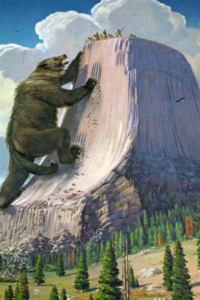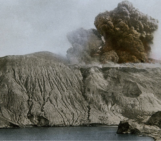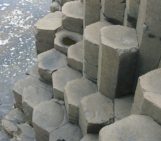
Geomythology.
Devils tower: born from hell?
Following the previous two posts (Giant’s Causeway – the mythical stone way; Columnar Basalts and why Hexagons are nature’s favourite shape) it is clear how columnar joints are quite common around the globe, and they create such a marvelous natural environment that inspired amazing myths and legends: the Devils Tower myth is one of them.
Devils Tower or Bear Tipi ?
The name Devils Tower derives from an unsuccessful translation made at end of the 1800s by Colonel Richard I. Dodge, who translated the original name to Bad God’s Tower, and so into Devils Tower. The monolith does not have a single name, but several, mainly linked by the figure of a bear. The original names given by Native American tribes living in the Black Hills area, such as the Lakota, the Arapahoe, the Cheyenne, the Shoshone, the Crown and the Kiowa, referred to it as the Bear Tipi (Lodge), Grizzly Bear Tipi, Bear Mountain or Tree Rock. Thus, such translation completely changed the meaning of the monolith’s name as well as its spiritual origins.
Besides all the Bear Tipi myths are fascinating, I particularly like the Cheyenne’s one (Fig.1), especially because those who told it, really believed it happened. The following myth, was originally told by Young-Bird, a Cheyenne elder, who also commented “This is a true story” (National Park Service, USA).

Fig.1. This painting depicts the Cheyenne narrative about the Devils Tower. Source: NPS / Herbert Collins.
The Big Rock was a well-known holy place to worship the Great Spirit, therefore members of every tribe in the surroundings would camp there for several days; among them a group of Cheyenne.
After several days of camping and worshipping, one of the Cheyenne realized that his wife would occasionally leave the camp for short periods. With time, however, he noticed that she was leaving the camp for longer and longer, without any explanation. Initially, he felt a sense of disbelief; until then he gave everything to his wife. He was devoted, he was a good hunter providing buffalo, antelope and deer meat, he furnished his wife with the best skins to make nice clothes, why would she leave without explanation?
With time, he became suspicious she was hiding an affair with another man in the camp. He decided to observe and count every man in the camp while his wife was away, but no one was missing. One day, she disappeared for a long time, and she came back with a new skin cloth, that she did not wear before leaving the camp. The man asked about her behaviour but he did not receive any answer; enraged, he snatched her new fur away from her and noticed, with shock, that her back was full of scratches. The man pretended to know who did that to her, frightening his wife, who decided to talk. She revealed that it was no man who injured her, but a giant bear living under the Big Rock. The bear lived alone inside a cave, became infatuated with the woman and approached her. The woman finally submitted to his advances for the sake of the campsite, fearing the anger of the bear.
The two decided to approach the cave, where they found the huge bear who had clawed the wife. The bear reacted by transforming her into a bear herself! The man retreated to the camp to ask the other Cheyenne to help him kill the bear. Once the Cheyenne group arrived at the cave, they could not kill the bear since the Bear was hiding in the cave and they could only see the Bear’s giant paws at the entrance. The Cheyenne decided to target his back paws with their arrows in order to drive the bear out and kill him. They managed to draw the bear out, however, the bear was too big, even for them, therefore the Cheyenne prayed to the Great Spirit asking to be rescued. In reply, the Great Spirit made the Big Rock grow high above the ground, with the men on top.
The rock was now so high that the bear tried and failed several times to reach the top. Every time he tried, he would sink his claws in the rock creating long vertical scratches, which are still visible today. After four attempts, the bear reached the top and the men, assisted by the Great Spirit, were able to slay the bear. The Bear’s corpse then fell off the top of Big Rock toppling it slightly to the side. Now, the big rock is the home of the bear-woman and it is called Bear Tipi by the Cheyenne.
With time, past and modern geologists were able to explain both the origin of the columnar basalts and the mode of emplacement.
Devils Tower geological origins
The Devils Tower is a huge monolith located in the USA within the Black Hills, which dominates the landscape from its 1558 m of elevation asl (Fig. 2a). The monolith “represents the world’s finest example of columnar jointing in phonolite and possibly the longest columns developed in a volcanic rock” Zavada et al. (2015).

Fig.2. Field photographs of Devils Tower observed from the NE (a) and from the NW. B: the base, S: the shoulder, LC: lower colonnade, UC: upper colonnade. After Zavada et al. (2015).
The Devils Tower derives from the Cenozoic igneous activity of the Black Hills, which underwent a strong uplift due to lithosphere scale folding starting ca. 65 Ma during the Laramide orogeny (e.g. Lisenbee and DeWitt, 1993; Tikoff and Maxson, 2001).
However, its true geological origin has been debated for more than 100 years, since the first scientific publication by Carpenter (1888). The emplacement of the Devils Tower has been explained by different authors as related to a specific magmatic body (Fig. 3), such as i) a magmatic stock, ii) a laccolith, iii) a volcanic conduit, iv) a volcanic neck extruded from a Christmas tree laccolith, v) a superficial lava body or vi) a welded pyroclastic material emplaced inside a maar crater (detailed review by Zavada et al., 2015).

Fig. 3. Sketch of the main magmatic bodies and features. For detailed description of each magmatic body refer to the blog Geology.com
The Devils Tower can be subdivided into four zones based on the different arrangement of the columnar joints (Fig. 2b): the base, the shoulder, the lower colonnade and the upper colonnade. The particularity of the Devils Tower is that its overall geometry changes depending on the point of view; if viewed from the northwest it appears almost symmetrical, moving northeastwards the columns of the northwest side are gently curved, while on the southeast side, they are straight. Such asymmetry, was explained by Zavada et al. (2015) who also suggested a new emplacement hypothesis for the Devils Tower.
The new interpretation (Fig. 4) suggests that an initial phreatomagmatic eruption excavated host rocks, whose explosion formed a cone-shaped diatreme at depth and a circular crater on the surface (maar, Fig. 3). Such eruption was followed by a pure effusive activity due to an insufficient amount of groundwater necessary to promote the phreatomagmatic explosion. The magma intruding the maar was then extruded on the surface to form a dome flow filling the entire maar. During this period, the columnar joints formed due i.e. to cooling by fluids released by the wet base of the maar. Subsequently, the phreatomagmatic volcano and the lava dome were eroded from the sides, leaving behind only the central part located just above the original conduit, where the cooling made it less prone to erosion (Zavada et al., 2015).

Fig.4. Schematic block diagrams explaining the geological origin of Devils Tower and sketches of typical microstructures and mesoscale outcrops in the maar-diatremes volcanoes. From Zavada et al. (2015).
References
Carpenter, F.R., 1888. Notes on the geology of the Black Hills. In Carpenter, F.R. (ed.) Preliminary report upon the geology, mineral resources and mills of the Black Hills of Dakota. Rapid City, Dakota Territory, Dakota School of Mines Preliminary Report, p. 11–52.
Lisenbee, A.L., and DeWitt, E., 1993. Laramide evolution of the Black Hills uplift. In A.W. Snoke et al. (eds.) Geology of Wyoming: Geological Survey of Wyoming Memoir 5, p. 374–412.
National Park Service, Devils Tower. https://www.nps.gov/deto/index.htm. Consulted on 21.01.2023.
Tikoff, B., and Maxson, J., 2001. Lithospheric buckling of the Laramide foreland during Late Cretaceous and Paleogene, western United States. Rocky Mountain Geology 36, 13–35. doi: https://doi.org/10 .2113/gsrocky.36.1 .13.
Zavada, P., Dědeček, P., Lexa, J., Keller, G.R., 2015. Devils Tower (Wyoming, USA): A lava coulee emplaced into a maar-diatreme volcano? Geosphere 11(2), 354–375. doi: https://doi.org/10.1130/GES01166.1.




